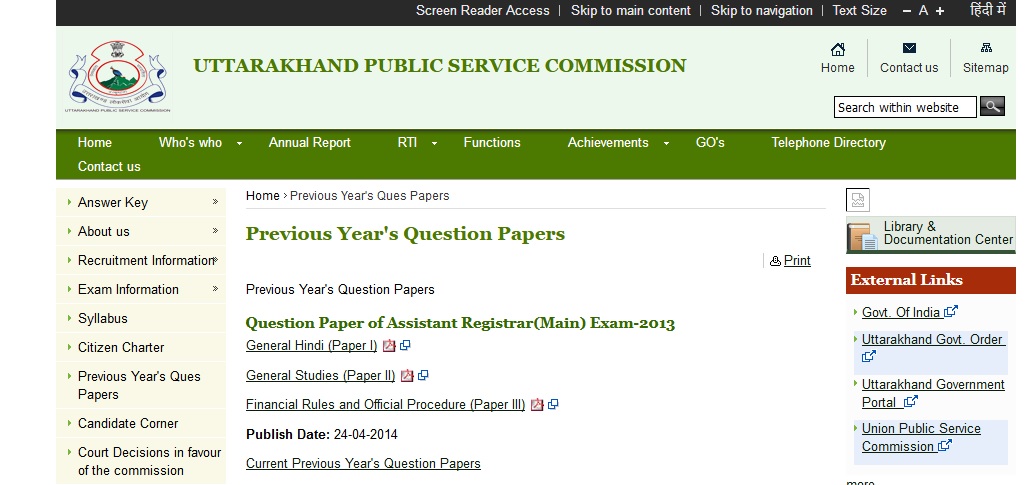UPSC Assistant Labor Commissioner in JTS Sample Question Paper 2015 : Union Public Service Commission
Name of the Organisation : Union Public Service Commission
Name of the Post : Assistant Labor Commissioner in JTS Sample Question Paper 2015
Year : 2015
Website : https://www.upsc.gov.in/
Download Sample Question Paper : https://www.pdfquestion.in/uploads/8251ALC.pdf
UPSC Labor Commissioner JTS Question Paper
1. Which one of the following explanations is indicated by the term ‘welfare’ as a total concept?
(a) It is a desirable state of existence involving physical, mental, moral and emotional well-being
Related : UPSC Combined CBRT Assistant Public Prosecutor Sample Question Paper 2015 : www.pdfquestion.in/8255.html
(b) It is the welfare of man, his family and community
(c) It is contingent upon time and space
(d) It demands certain minimum acceptable conditions of existence, biologically and socially
2. ‘Atonement’ and ‘Investment’ are two co-equal aspects of which one of the following labour welfare theory?
(a) The Philanthropic theory
(b) The Placating theory
(c) The Public Relations theory
(d) The Religious theory
3. The first Factories Act for India was enacted in the year:
(a) 1948
(b) 1881
(c) 1911
(d) 1891
4. Which one of the following statements with regard to the provision for ‘Welfare Officer’ is NOT correct?
(a) This provision is given in the Factories Act 1948
(b) This provision, in case of Mines and Plantations, is given in the central rules of these two Acts but not in the main Acts
(c) For factories and plantations this provision is applicable when 500 or more workers are employed
(d) In mines this provision is made applicable when 500 or more workers are employed
5. Which one of the following is NOT a ‘welfare measure’ under the Factories Act 1948?
(a) Drinking water
(b) Crèches
(c) First aid
(d) Canteen

6. Under the provisions of the Maternity Benefit Act 1961, what is the amount of medical bonus paid?
(a) Rs. 1,000
(b) Rs. 2,500
(c) Rs. 3,000
(d) Rs. 3,500
7. Under the Maternity Benefit Act 1961, what is the minimum number of days a woman employee must have worked under an employer in the twelve months preceding the date of expected delivery for becoming eligible for maternity benefit?
(a) 90 days
(b) 80 days
(c) 180 days
(d) 240 days
8. Under the provisions of the Employees’ Compensation Act 1923, what will be the amount of compensation payable to an employee suffering from permanent total disability with his monthly salary drawn Rs. 15,800 and the relevant factor 181.37?
(a) Rs. 7,75,376
(b) Rs. 5,40,000
(c) Rs. 8,70,576
(d) Rs. 1,40,000
9. Who among the following is NOT a dependent under the provisions of the Employees’ Compensation Act 1923?
(a) A widower
(b) An adult widowed sister
(c) A parent other than a widowed mother
(d) A widowed daughter – in – law
10. Who among the following is the ex-officio Chairman of the Medical Benefit Council constituted under the Employees’ Insurance Act 1948?
(a) The Director General, Health Services, Government of India
(b) The Medical Commissioner of the Employees State Insurance Corporation
(c) The Director General, Employees State Insurance Corporation
(d) Chairman, Medical Council of India
11. Under the provisions of the Maternity Benefits Act 1961, every women employee after delivery of a child who returns to duty is to be provided with nursing breaks till the child attains the age of:
(a) Twelve months
(b) Fifteen months
(c) Ten months
(d) Eighteen months
12. Which one of the following statements about industrial relations is NOT correct?
(a) Industrial relations have to be managed in the interest of maintaining a viable collaborative structure
(b) Formulation of rules by consensus and their implementation are core to industrial relations
(c) The pluralistic framework looks employee participation in industrial relations from a disintegrative perspective
(d) The radicalists consider industrial relations in a distributive sense
13. Which one of the following is NOT a logic of industrial relations?
(a) The logic of conflict
(b) The logic of competition
(c) The logic of industrial peace
(d) The logic of employment – income protection
14. What is a ‘Wild – Cat’ strike?
(a) Strike called by the workers with the support of union with notice to the employer
(b) Strike called by a group of workers on the spur of the moment without any formal notice to the employer and consent from the union
(c) Strike called by the union without resorting to strike ballot
(d) Strike called by non-unionised workers, even if notice is given to the employer
15. Which one of the following is a ‘jurisdictional strike’?
(a) Two unions claiming the office space conduct strike
(b) Two unions conduct strike for registration with the same name
(c) Two unions may claim to represent the same set of workers and may clamour for recognition on this claim and go for a strike to pressurize the management
(d) Two unions claiming possession of a common seal go for strike to elicit the support of workers
Which one of the following explanations is indicated by the term ‘welfare’ as a total concept?